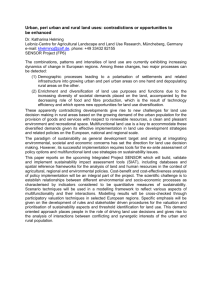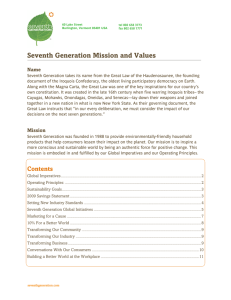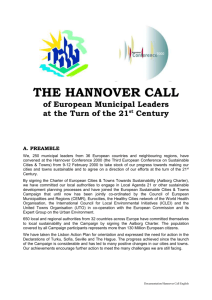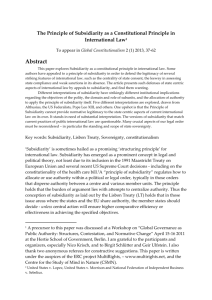The 7th EAP focus on sustainable cities
advertisement
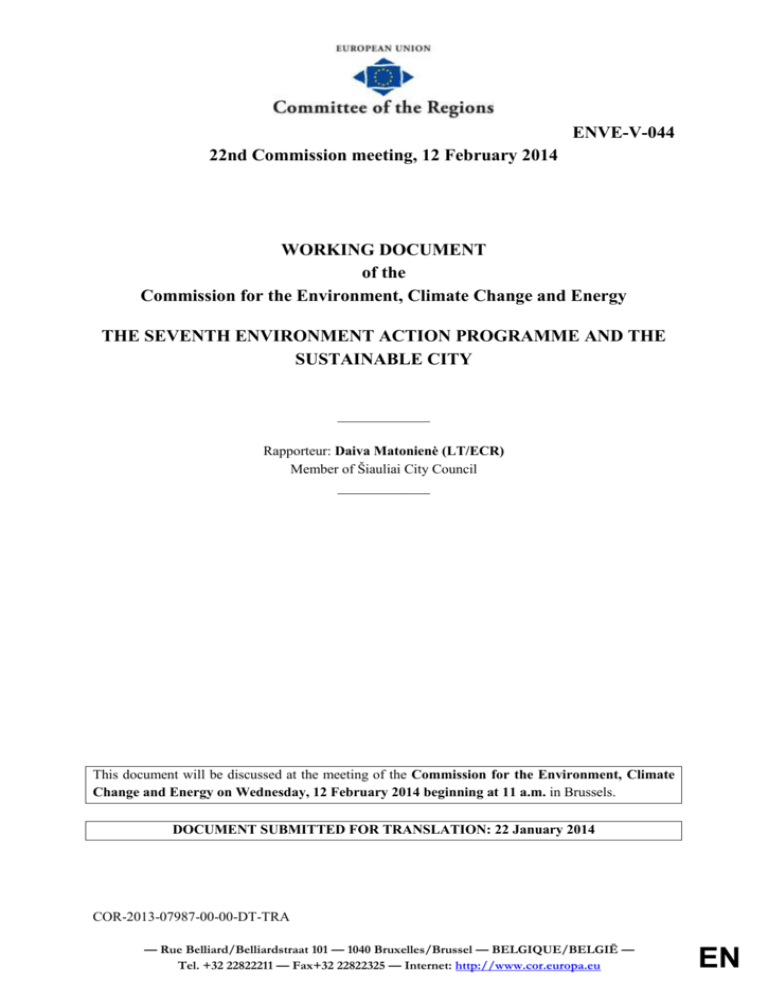
ENVE-V-044 22nd Commission meeting, 12 February 2014 WORKING DOCUMENT of the Commission for the Environment, Climate Change and Energy THE SEVENTH ENVIRONMENT ACTION PROGRAMME AND THE SUSTAINABLE CITY _____________ Rapporteur: Daiva Matonienė (LT/ECR) Member of Šiauliai City Council _____________ This document will be discussed at the meeting of the Commission for the Environment, Climate Change and Energy on Wednesday, 12 February 2014 beginning at 11 a.m. in Brussels. DOCUMENT SUBMITTED FOR TRANSLATION: 22 January 2014 COR-2013-07987-00-00-DT-TRA — Rue Belliard/Belliardstraat 101 — 1040 Bruxelles/Brussel — BELGIQUE/BELGIË — Tel. +32 22822211 — Fax+32 22822325 — Internet: http://www.cor.europa.eu EN -1Introduction The underlying principle of the European Union's general Environment Action Programme (EAP), "Living well, within the limits of our planet", is the broad commitment and willingness of the Member States and the relevant EU institutions to take responsibility for ensuring that the programme actually achieves its intended benefits. So far, however, the measures taken by the EU have fallen short. Further measures will have to be taken to meet these challenges if long-term prosperity is to be secured in the EU. Objectives connected to the seventh EAP In the interest of efficient use of resources and a low-carbon economy that protects and grows natural capital and safeguards public health and wellbeing, the seventh EAP is meant to provide a legal framework for environmental policy up to 2020 and to set priority long-term targets for 2050 for the EU and its Member States. There are nine primary objectives, including making the EU's cities more sustainable. Issues to be considered in the Committee of the Regions' opinion Over the past hundred years, Europe has developed from an agriculture-based to an urbanised continent. Censuses show that as much as 70% of the EU's population, some 350 million people, already live in towns and cities with more than 5 000 residents. Even if the trend has slowed down recently, this figure is bound to increase further. In all likelihood, 80% of Europeans will live in cities or suburbs by 2020. Quality of life will directly depend on the state of the urban environment. Cities' impact on the environment goes far beyond their geographical borders, since they depend strongly on peri-urban and rural areas to meet their food, energy, space and resource needs and to process waste. Another trend is visible in cities: they are becoming increasingly run-down and decrepit. These factors should be taken into account in urban planning and investment. On the other hand, if the principles of sustainable urban development are respected and projects that reflect them are carried out, cities can be made into attractive living spaces criss-crossed and interconnected with convenient public transport networks. Most cities essentially face the same major environmental problems: problems with air quality, excessive noise pollution, traffic congestion, greenhouse gas emissions, biodiversity loss, water shortages, floods and storms, shrinking green space, contaminated land, derelict industrial land, and inefficient waste management and energy provision. At the same time, EU cities set standards for urban sustainability and often pioneer innovative solutions to environmental problems, not least in terms of resource efficiency and initiatives for a green economy that are relevant to the Europe 2020 strategy. Ever more European cities are putting environmental sustainability at the heart of their urban development strategies. COR-2013-07987-00-00-DT-TRA …/… -2That is why the EU has declared making cities more sustainable one of its overriding priorities and a key for successfully implementing environmental policy. The European Commission has asked the Committee of the Regions to issue an opinion on the proposed measures for implementing the seventh Environment Action Programme's eight objectives and, with this in mind, posed four questions: (a) How can the European Union encourage cities to take urban planning and design measures that reflect the principles of sustainable development? (b) How could dissemination of information about existing and available EU funding instruments for promoting sustainable development of cities be improved? (c) How could the EU foster more efficient exchange of information and know-how on the best ideas and measures concerning sustainable cities in the EU? (d) How can cities of more than 100 000 be encouraged to contend for the title of European Green Capital? With these questions in mind, the Committee wishes to make the following general remarks. The first important principle of sustainable urban development is a holistic, or integrated, approach that resolves both environmental and social problems in a city. Without an integrated approach it is impossible to put the concept of the sustainable city into practice. That is why this approach should not be limited to environmental protection, for social protection, education, employment and economic development, for example, are no less important for society's well-being. A second important principle is that the environment is of fundamental importance in creating sustainable cities. Including considerations related to environmental protection in all relevant policy areas is crucial to mitigating environmental pressures caused by other sector-specific strategies and activities and to meeting environmental and climate targets. Since, under the principle of subsidiarity, sustainable urban planning and spatial planning fall within the remit of the Member States, it is imperative that this principle be upheld. A procedure has to be developed and a legal basis established to ensure that the principles of sustainable development are promoted in spatial planning through national legislation and that urban development plans and principles are strictly regulated. Although the Member States are responsible for spatial planning under the principle of subsidiarity, the European Commission should develop common recommended criteria for implementing the principle of sustainable cities which cities could use to assess the current situation and risks and that would help them to take more targeted investment decisions. Cities should aim for horizontal and vertical coordination, ensuring a comprehensive approach to urban development in order to avoid making isolated and uncoordinated investments. Improved procedures for coordination at national and regional level and the creation of a "network for sustainable urban development" would help to achieve all this and make it possible to involve more interest groups and the wider public in decisions affecting them. Further developing tools to rationalise environmental data collection and management and that make it easier to share experience and tried and tested methods would also benefit local and regional authorities. Attention should not be limited to major cities of more than 100 000 people. Small and mediumsized towns and cities, especially in the smaller Member States, could play an important role in tackling rural depopulation. Strong provincial cities can form the backbone of a country. COR-2013-07987-00-00-DT-TRA …/… -3- Moreover, there is greater potential in small and medium-sized towns and cities to conceive and implement ideas for sustainable urban development. These concepts should be adapted and discussed at national and local level with the close involvement of the public. Based on the European Commission's recommended criteria for a sustainable city, cities should therefore carry out an evaluative analysis of sustainable urbanism and use this to draw up strategies for the development of sustainable cities by 2050. The seventh EAP should also be implemented by way of other existing or planned legislation with a direct or indirect bearing on urban planning and associated measures. When taking investment decisions, basic, integrated criteria should be set at European and national level where necessary for sustainable urban development. The European Commission should draw up and negotiate at EU level a list of sustainability criteria for cities providing a common basis for initiatives in this area and encouraging a consistent and integrated approach to sustainable urban development. The Member States should adopt criteria and indicators for sustainable cities at national level, to be continuously assessed and monitored. In Europe there is currently a multitude of databases, opinions, forums and differing viewpoints concerning sustainable cities. Because this information is not gathered in one place, it cannot be effectively exploited. Either cities do not know whether they can find such information, or the data overlap or are not relevant. This also applies to some funding instruments designed for sustainable urban development measures. In the interest of efficiency, the Committee recommends following the principle of a one-stop shop pooling all information about legal and financial issues as well as shared experiences and methods. This could take the form of a platform, with consideration given to using existing structures or creating new ones. One of the key driving forces in making the sustainable city a reality comes from giving people opportunities for education and providing the corresponding incentives. Measures aimed at water conservation, expanding recycling and composting plants, boosting public transport use and saving energy do not by themselves amount to active and broad public involvement in building sustainable cities. The EU should further promote and, where appropriate, expand existing initiatives that support innovation and best practice in cities, networking and exchange, and cities should be encouraged to take the lead in sustainable urban development, which is why the Committee recommends considering the creation of a special investment instrument and corresponding eligibility criteria enabling competition between sustainable urban development projects. It is worth considering, at European and national level, pilot projects in small and medium-sized cities applying the best available methods in all fields, including transport, housing, social issues, health, education and environmental protection. A database should be set up at national and European level and criteria developed to inform a common understanding of what helps to create a better urban environment. Such criteria would make it possible to draw on only the best methodologies and to adapt existing models and funding instruments. The Member States and cities have to decide not only on these criteria, but also on the efficiency benchmarks against which cities can better assess the implementation of measures. It should be assessed at European and national level whether a uniform approach exists to measures promoting the development of sustainable cities, and whether the possibilities open to COR-2013-07987-00-00-DT-TRA …/… -4- cities are not being limited by the legislation in force. A uniform approach and flexible procedures would allow cities to choose the best measures for sustainable urban development in the long run. The contest for the title of European Green Capital requires conceptual changes. There are already nomination procedures that work well in the EU, such as those for the European Capital of Culture. Nominations for the European Green Capital should also be developed in this direction, moving from a mere initiative to a legally and financially regulated award. It is also worth considering whether the criteria should be loosened to include cities with as few as 50 000 people, thereby increasing the opportunities available to European cities. The title-holders and contestants for the title of European Green Capital should compare notes on successful outcomes and technical ideas using their own platform or existing structures. It is important to promote an effective partnership between the public and private sectors so that projects that reflect the idea of the sustainable city are implemented as efficiently as possible. Existing funding opportunities and structures should be better used and new ones refined or created (through the EIB, for example). The principle of multi-level governance should be strengthened, since the most important driver of success at national and local level is cooperation on sustainable urban development and on a common approach, while at the level of cities it is responsibility for sustainable urban development. Conclusions If the European Union is to rise to the current challenges of sustainability, it is crucial to assess all of its existing policy areas, funding mechanisms, measures and platforms and to ensure that they are coordinated and accessible. The involvement of local and regional authorities in the EU's legislative process is likely to ensure better implementation and greater acceptance, but also that those authorities commit to the political objectives of their own accord. The policy areas environmental protection and sustainable urban development should be recognised as new challenges in the Member States. To this end, sustainability criteria should be recommended for cities which they can use to take stock of their situation and to draw up risk and action plans and corresponding strategies. With an eye to efforts to shape a uniform approach to sustainable urban development at European, national and local level, the Committee recommends that the European Commission develop recommended criteria for urban sustainability. At the same time, in order to evaluate the efficiency of measures, it is worth considering potential indicators making it possible to revise and assess the efficiency of a city's activities and of progress made on an ongoing basis. The current structures for exchanging shared practices are insufficient because they are too specialised, not active enough or overlap. Cities have too few opportunities to exchange and use tried and tested practices and to obtain information on existing funding initiatives and mechanisms in good time, which is why the Committee proposes that a broad structure for exchanging shared practices be COR-2013-07987-00-00-DT-TRA …/… -5set up at European level, based on a holistic approach and reflecting all aspects of sustainable urban development. The recognition of European Green Capitals is a highly valuable and important step on the road to sustainable cities and should continue. However, administrative and financial changes are needed to the concept to ensure that the measures that the cities take are maintained and continue to be supported, and to keep up competition between cities for the title. __________ COR-2013-07987-00-00-DT-TRA








